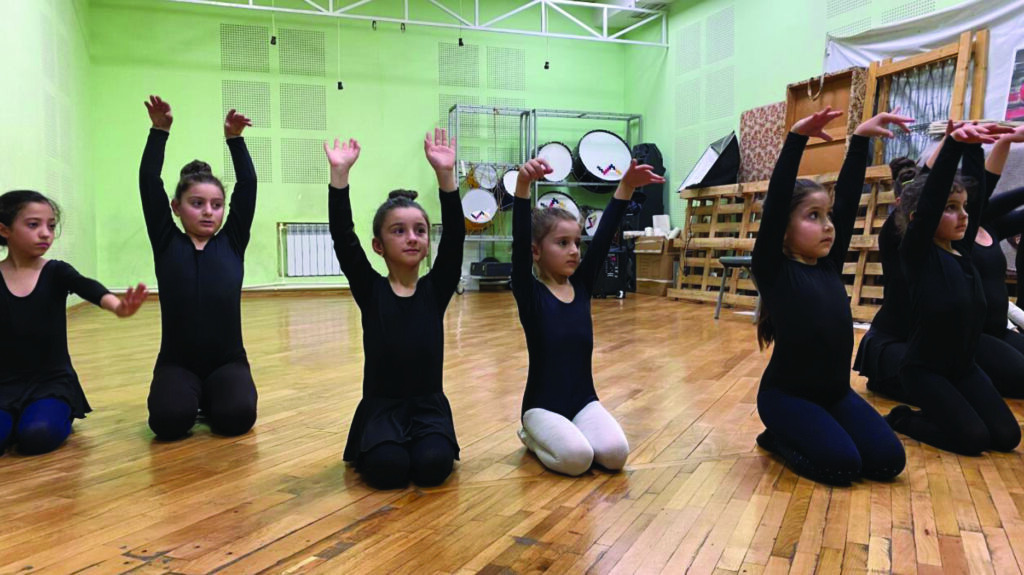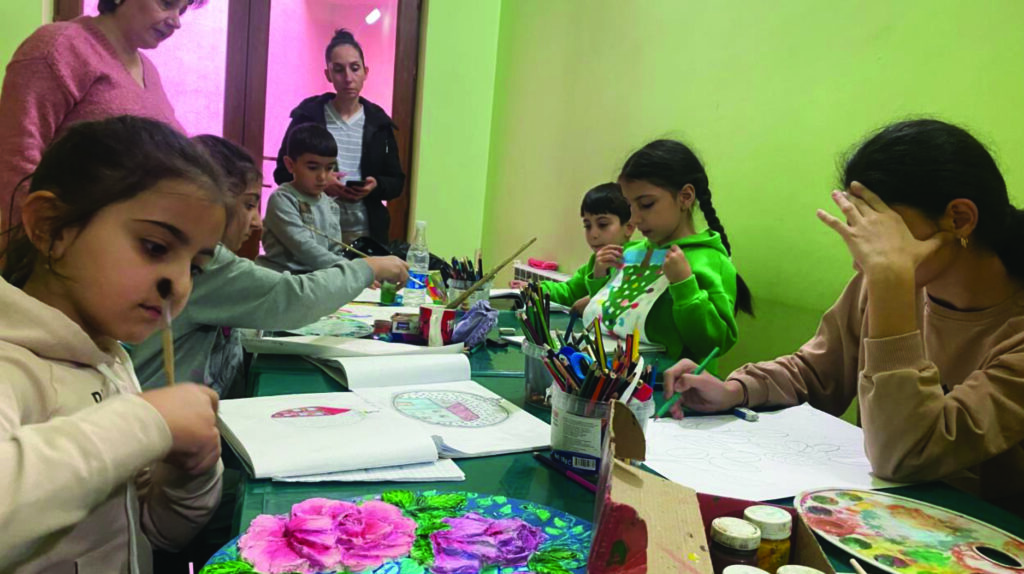When Alexandra Avanesyan, a fine arts teacher at Hadrut art school, asked her students to draw their dream house, sisters Mane and Milena from Togh village said they had already lost theirs. Mane, who attended first grade in her native village for only three weeks before the 2020 war forced her to flee, doesn’t remember her school or classmates. But her eyes light up for a moment and then fill up with tears when she talks about her home. “It was the most beautiful house, two-story, with flowers in the yard and a fence.”
During the 44-day war that Azerbaijan launched against Artsakh in 2020, the region of Hadrut, along with Shushi, was violently conquered by Azerbaijan, creating an internally displaced population of 13,500 people. About 5,380 of them live in Artsakh; almost the same number live in the Republic of Armenia. The rest have emigrated abroad.
Azerbaijan’s political propaganda often invokes the large number of Azerbaijani refugees/displaced persons from the 1990s war, which in numbers is almost comparable to displaced Armenians from the same era (a fact that Azerbaijan conveniently omits). Yet there is rarely mention of the ethnically cleansed indigenous Armenians of Hadrut, who became homeless just two years ago.
On March 20, forcibly displaced Armenians of Artsakh called on UNHCR, Pashinyan, Putin and Aliyev to organize their return to their homes.
Today, over two years after the war, the displaced people of Hadrut are mostly settled in Artsakh’s capital Stepanakert. According to Artur Baghdasaryan, head of the administration of the Hadrut region in exile, the government in Stepanakert is building housing for former residents of Hadrut. Construction on a residential district with over 250 apartments was underway until Azerbaijan’s blockade of Artsakh, which shut down all construction projects due to the lack of imported building materials. Were it not for the blockade, the first set of houses would have been completed by now.
The enduring blockade has also impacted employment prospects, with massive layoffs by businesses that have neither supplies nor outside markets to work with. In addition to housing, employment and social problems, the displaced people of Hadrut also face challenges in realizing the right to an education and freedom of creative expression. Having lost their homes and schools, people from Hadrut now conduct their art lessons at the Komitas Music School in Stepanakert. In addition, due to high demand, the teachers offer art classes on weekends as well. This all impacts the quality of education and the educators’ well-being.
Tatevik Mkrtchyan was hired to direct the Hadrut art school about a month before the 44-day war. After taking refuge in the Republic of Armenia, Mkrtchyan returned to Artsakh immediately after the war, despite losing her home in Hadrut. She understood the importance of maintaining Hadrut’s education system in exile as a way to preserve their culture and also encourage displaced people to return to Artsakh, despite having lost their ancestral villages.
Today, more than 100 students attend the dance, theater, fine arts, clothing modeling and decorative-applied arts departments at the relocated Hadrut art school, which is an extracurricular school. Most students are displaced from different settlements of the Hadrut region.

“At first, you reject reality. Then you accept it, and then you try to overcome it,” says Mkrtchyan.
Since the building conditions are not satisfactory, she is forced to combine her administrative work in the director’s office during choir practice. “We even conduct painting classes in the kitchen. But we are not complaining. At least in these conditions, we are able to educate the children and bring them closer to the world of art,’’ she added.
Despite all odds, neither the administrators nor the teachers have lost hope in returning to Hadrut one day. Until then, they want to live together as a community. If they build houses close to each other, the school intended for Hadrutsis should be close by.
“If there is hope to return to our homes to Hadrut, we must keep our traditions alive. My great-grandmother was a native of Shushi. After the 1920 massacres in Shushi, her family, along with nearly all Armenian residents of Shushi, dispersed, instead of creating a community in exile. When Shushi was liberated in 1992 during the first Karabakh war, they did not return to their hometown, and other displaced Armenians lived in Shushi instead of them.” Mkrtchyan thinks that they shouldn’t make the same mistake. “When we go back to our homes in Hadrut one day, we, our children and grandchildren should live there,” she added.

In this environment, displaced people from Hadrut are also able to preserve their dialect, customs and memories. This is important not only for them but Armenians and indigenous peoples everywhere. Throughout the centuries, Armenian communities have been repeatedly displaced by war or earthquake. Until 2020, Hadrut was one of the few corners of the Armenian homeland where the people had lived in the same region for many centuries, if not millenia, without displacement. Gatherings between and after classes and conversations in Hadrut’s sweet and unique dialect may slightly ease the longing and pain. “For us, talking about the butcher from Hadrut or sharing the success story of Nora, who opened a sweet shop in Yerevan, with the dialect of Hadrut is more valuable,’’ added Mkrtchyan.
Outside this community, there has been little appreciation for Hadrut’s unique dialect and enduring culture. Among the exceptions is Yerevan-based author Arpy Maghakyan’s 2022 children’s book Sun-kissed Shushi, in which a poem about the legendary tree Tnjri is presented in the Hadrut dialect. But recognition of Hadrut’s unique place in Armenian ethnography is not enough for cultural survival. The Stepanakert-based people from Hadrut know this all too well, which is why they consciously rely on each other not only for cultural preservation, but in daily life. If someone needs to find an apartment or a job, they all try to organize it through their acquaintances. Helping each other and sticking together is a strategic choice, even if that may make life harder. “It’s not that we provide better education than other schools in Stepanakert. It is not even appropriate that in the art school we teach children of different ages in the same groups together. We also work on Saturdays and Sundays, but we have no other option,” said Avanesyan. “I am afraid that we will lose ourselves too. We have already lost a lot of each other, and we must keep those memories, traditions and our dialect alive, even in exile.” She notes that children are the key to this survival, and she has reasons to feel hopeful since “children understand everything, and all their dreams are related to returning home.”
The people of Hadrut today, who are based in Stepanakert, live less than 100 kilometers away from their ethnically cleansed and occupied homes. Yet they make the choice to keep Hadrut alive, for the sake of their own well-being and for future generations. “If you don’t have a home, it’s like you’re lost. You can’t find your place in this world.”




Be the first to comment